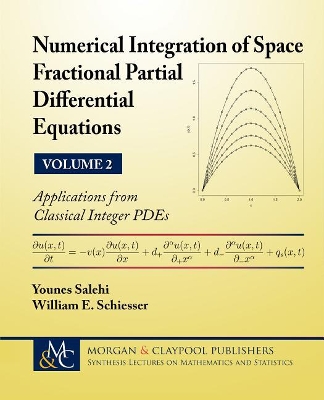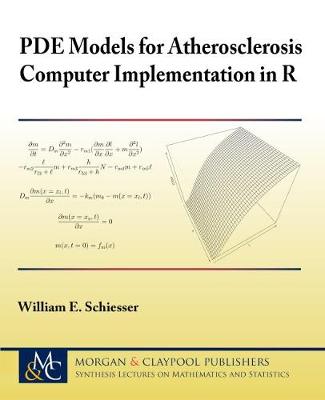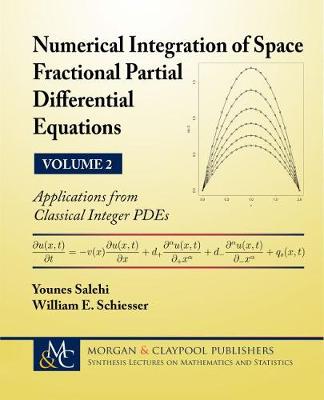Synthesis Lectures on Mathematics and Statistics
3 total works
Numerical Integration of Space Fractional Partial Differential Equations
by Younes Salehi and William E Schiesser
Published 27 November 2017
Partial differential equations (PDEs) are one of the most used widely forms of mathematics in science and engineering. PDEs can have partial derivatives with respect to (1) an initial value variable, typically time, and (2) boundary value variables, typically spatial variables. Therefore, two fractional PDEs can be considered, (1) fractional in time (TFPDEs), and (2) fractional in space (SFPDEs). The two volumes are directed to the development and use of SFPDEs, with the discussion divided as: Vol 1: Introduction to Algorithms and Computer Coding in R Vol 2: Applications from Classical Integer PDEs. Various definitions of space fractional derivatives have been proposed. We focus on the Caputo derivative, with occasional reference to the Riemann-Liouville derivative. Partial differential equations (PDEs) are one of the most used widely forms of mathematics in science and engineering. PDEs can have partial derivatives with respect to (1) an initial value variable, typically time, and (2) boundary value variables, typically spatial variables. Therefore, two fractional PDEs can be considered, (1) fractional in time (TFPDEs), and (2) fractional in space (SFPDEs). The two volumes are directed to the development and use of SFPDEs, with the discussion divided as: Vol 1: Introduction to Algorithms and Computer Coding in R Vol 2: Applications from Classical Integer PDEs. Various definitions of space fractional derivatives have been proposed. We focus on the Caputo derivative, with occasional reference to the Riemann-Liouville derivative. The Caputo derivative is defined as a convolution integral. Thus, rather than being local (with a value at a particular point in space), the Caputo derivative is non-local (it is based on an integration in space), which is one of the reasons that it has properties not shared by integer derivatives. A principal objective of the two volumes is to provide the reader with a set of documented R routines that are discussed in detail, and can be downloaded and executed without having to first study the details of the relevant numerical analysis and then code a set of routines. In the first volume, the emphasis is on basic concepts of SFPDEs and the associated numerical algorithms. The presentation is not as formal mathematics, e.g., theorems and proofs. Rather, the presentation is by examples of SFPDEs, including a detailed discussion of the algorithms for computing numerical solutions to SFPDEs and a detailed explanation of the associated source code.
PDE Models for Atherosclerosis Computer Implementation in R
by William E Schiesser
Published 7 November 2018
Atherosclerosis is a pathological condition of the arteries in which plaque buildup and stiffening (hardening) can lead to stroke, myocardial infarction (heart attacks), and even death. Cholesterol in the blood is a key marker for atherosclerosis, with two forms: (1) LDL - low density lipoproteins and (2) HDL - high density lipoproteins. Low LDL and high HDL concentrations are generally considered essential for limited atherosclerosis and good health.
This book pertains to a mathematical model for the spatiotemporal distribution of LDL and HDL in the arterial endothelial inner layer (EIL, intima). The model consists of a system of six partial differential equations (PDEs) with the dependent variables
1. concentration of modified LDL
2. ℎ concentration of HDL
3. concentration of chemoattractants
4. concentration of ES cytokines
5. density of monocytes/macrophages
6. density of foam cells and independent variables
1. distance from the inner arterial wall
2. time
The focus of this book is a discussion of the methodology for placing the model on modest computers for study of the numerical solutions. The foam cell density as a function of the bloodstream LDL and HDL concentrations is of particular interest as a precursor for arterial plaque formation and stiffening.
The numerical algorithm for the solution of the model PDEs is the method of lines (MOL), a general procedure for the computer-based numerical solution of PDEs. The MOL coding (programming) is in R, a quality, open-source scientific computing system that is readily available from the Internet. The R routines for the PDE model are discussed in detail, and are available from a download link so that the reader/analyst/researcher can execute the model to duplicate the solutions reported in the book, then experiment with the model, for example, by changing the parameters (constants) and extending the model with additional equations.
This book pertains to a mathematical model for the spatiotemporal distribution of LDL and HDL in the arterial endothelial inner layer (EIL, intima). The model consists of a system of six partial differential equations (PDEs) with the dependent variables
1. concentration of modified LDL
2. ℎ concentration of HDL
3. concentration of chemoattractants
4. concentration of ES cytokines
5. density of monocytes/macrophages
6. density of foam cells and independent variables
1. distance from the inner arterial wall
2. time
The focus of this book is a discussion of the methodology for placing the model on modest computers for study of the numerical solutions. The foam cell density as a function of the bloodstream LDL and HDL concentrations is of particular interest as a precursor for arterial plaque formation and stiffening.
The numerical algorithm for the solution of the model PDEs is the method of lines (MOL), a general procedure for the computer-based numerical solution of PDEs. The MOL coding (programming) is in R, a quality, open-source scientific computing system that is readily available from the Internet. The R routines for the PDE model are discussed in detail, and are available from a download link so that the reader/analyst/researcher can execute the model to duplicate the solutions reported in the book, then experiment with the model, for example, by changing the parameters (constants) and extending the model with additional equations.
Numerical Integration of Space Fractional Partial Differential Equations, Volume 2
by Younes Salehi and William E Schiesser
Published 6 December 2017
Partial differential equations (PDEs) are one of the most used widely forms of mathematics in science and engineering. PDEs can have partial derivatives with respect to (1) an initial value variable, typically time, and (2) boundary value variables, typically spatial variables. Therefore, two fractional PDEs can be considered, (1) fractional in time (TFPDEs), and (2) fractional in space (SFPDEs). The two volumes are directed to the development and use of SFPDEs, with the discussion divided as:
Various definitions of space fractional derivatives have been proposed. We focus on the Caputo derivative, with occasional reference to the Riemann-Liouville derivative. In the second volume, the emphasis is on applications of SFPDEs developed mainly through the extension of classical integer PDEs to SFPDEs. The example applications are:
These SFPDEs were selected because they are integer first order in time and integer second order in space. The variation in the spatial derivative from order two (parabolic) to order one (first order hyperbolic) demonstrates the effect of the spatial fractional order ?? with 1 ≤ ?? ≤ 2. All of the example SFPDEs are one dimensional in Cartesian coordinates. Extensions to higher dimensions and other coordinate systems, in principle, follow from the examples in this second volume. The examples start with a statement of the integer PDEs that are then extended to SFPDEs. The format of each chapter is the same as in the first volume. The R routines can be downloaded and executed on a modest computer (R is readily available from the Internet).
- Vol 1: Introduction to Algorithms and Computer Coding in R
- Vol 2: Applications from Classical Integer PDEs.
Various definitions of space fractional derivatives have been proposed. We focus on the Caputo derivative, with occasional reference to the Riemann-Liouville derivative. In the second volume, the emphasis is on applications of SFPDEs developed mainly through the extension of classical integer PDEs to SFPDEs. The example applications are:
- Fractional diffusion equation with Dirichlet, Neumann and Robin boundary conditions
- Fisher-Kolmogorov SFPDE
- Burgers SFPDE
- Fokker-Planck SFPDE
- Burgers-Huxley SFPDE
- Fitzhugh-Nagumo SFPDE.
These SFPDEs were selected because they are integer first order in time and integer second order in space. The variation in the spatial derivative from order two (parabolic) to order one (first order hyperbolic) demonstrates the effect of the spatial fractional order ?? with 1 ≤ ?? ≤ 2. All of the example SFPDEs are one dimensional in Cartesian coordinates. Extensions to higher dimensions and other coordinate systems, in principle, follow from the examples in this second volume. The examples start with a statement of the integer PDEs that are then extended to SFPDEs. The format of each chapter is the same as in the first volume. The R routines can be downloaded and executed on a modest computer (R is readily available from the Internet).


